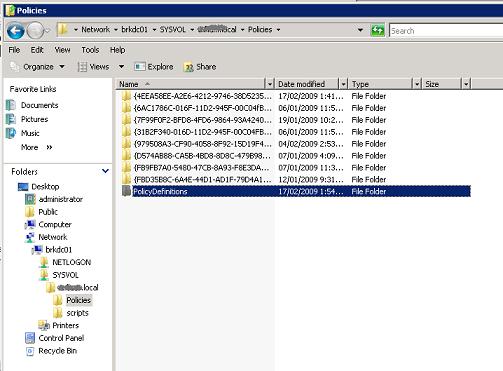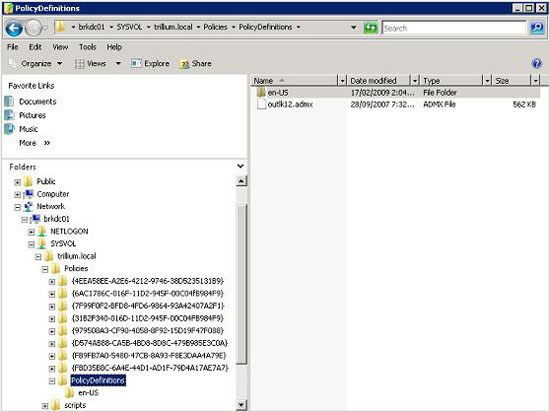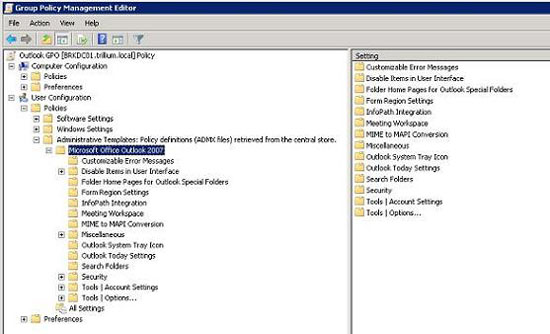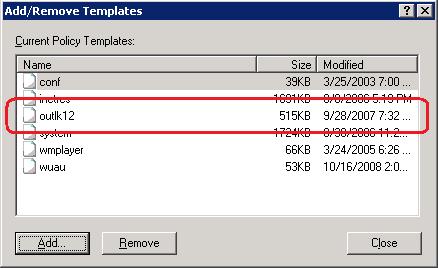Manage Outlook 2007 through Group Policies - Part 1
In this article, I will show you how to configure Outlook 2007 through Active Directory Group Policies.
Introduce
In this series, we will use Group Policies to help Exchange administrators manage some of Outlook 2007's features. There are many questions about Outlook 2007 configuration in Microsoft's technology forum, most of them. These questions can be processed through Group Policy. While it is impossible to remember all of them, here are some topics that we will cover in this article and it can be very useful in your environment: configuring outlook automatically, attaching, PST, schedule and how to allow or deny configuration of POP3 / IMAP4 accounts.
Deploy the System Administration Template files of Office 2007
First, let's download these Template files from the Microsoft Download Center. Double click on the downloaded file, then the registration agreement page will be displayed, read the agreement, when you approve, click Accept the terms and Continue. The process will create three folders and an xls file in a folder during the file extraction process, as shown in Figure 1 below.

Figure 1
Office2007GroupPolicyAndOCTSettings.xls file has three worksheets, the first version says that there are response files for each Office program, in the test case, we use Outlook12 files. *. The second worksheet has all ADM settings that can be configured in this sample file, while the third worksheet has all the configurations that can be used by Office Customization Tool. In this article, we will only use the second worksheet of that file, where we can see detailed information about registry keys, possible values, explanations, default settings and Possible settings that we can use for each item.
We acknowledge that you already know how to use the excel file that comes with Office 2007 Administrative templates, so we can add those template files to our current environment. The safe way to do this with Group Policy is to create a test Organization Unit (OU) and transfer some test users or computers to the test OU, create a Group Policy and a link to test that OU, then validating results on objects. Finally, document the entire process and create a strategy to 'roll back' the situation if necessary and then use the new Outlook Policies in the production environment.
The procedures required to add samples may vary, depending on your environment. We have extracted two formats (ADM or ADMX) so that the ADM files used by Windows Server 2003 and earlier versions and ADMX are now a new format approved by Windows Server 2008 and future versions. hybrid In the next section, we will add these templates to both scenarios.
Windows Server 2008
In Windows Vista and Windows Server 2008 operating systems, ADM files are replaced by ADMX files, which use the XML file format to display registry policy settings. The new format is not saved in each GPO but we can use some central storage location to store the templates and these storage locations will be replicated in all domain controllers of the domain. .
If you haven't set up a central storage location yet, let's start from the steps below:
- Log in as an administrator on a Domain Controller
- Click Start, Run and type, then click OK
- Double click on SYSVOL
- Double click
- Click on the Policies
- Click File, New and Folder
- Type PolicyDefinitions (Figure 2)

Figure 2
- Open the new PolicyDefinitions folder
- Create each folder for each language supported by your organization in En-US format.
Note : This document can help you validate that the department knows the right location.
Until now, we have configured Central Location. Now it's time to migrate our Central Location using the Outlook 2007 templates that have been extracted at the beginning of the lesson. Basically, we need to move the admx extensions to the root of PolicyDefinitions folder and expand adml to the directory of your chosen language, as shown in Figures 3 and 4.

Figure 3

Figure 4
Because we use Windows Server 2008, click tart, All Programs, Administrative Tools, and Group Policy Management Editor. Select the created OU for this test, then right-click it and select New GPO , enter the name in the GPO Name section and then click OK. Right-click the newly created GPO and click Edit .
Open User Configuration , Policies , Administrative Templates: Policy definitions (ADMX files) retrieved from the central store , Microsoft Office Outlook 2007, and you will see all the components that can be configured through this policy, see shown in Figure 5.

Figure 5
Windows Server 2003
The process of adding a template in Windows 2003's Group Policy is also quite simple. We can edit Group Policy directly from the Group Policy object properties, or use the Group Policy Management Console, which can be downloaded from Microsoft.
Both methods are valid, you can open Group Policy anyway, open User Configuration , right-click Administrative Templates , click Add / Remove Templates . , in the new window, click Add . , and find the outlk12.adm file from the extracted files in the Office 2007 Template package, the result will be the same as shown in Figure 6 below.

Figure 6
The results of all Group Policies related to Outlook 2007 will be listed and we can start the work with them.
Conclude
In this first article, I have shown you how to add Outlook 2007 templates to two operating systems (Windows Server 2003 and Windows Server 2008) using ADM or ADMX. In the next part of this series, we will do some operations with these templates to lock PST, filter attachments .
You should read it
- Microsoft lists Windows 10 group policies that you should avoid touching
- Configure Outlook 2007 with Exchange Server 2007
- How to create a Group Email in Outlook
- Speed up Microsoft Outlook 2007
- Instructions for sending free SMS via Outlook
- Microsoft has just released the 2007 Outlook 2007 update
- How to Archive in Outlook 2007
- Configure Web Services URL of Exchange Server 2007
May be interested
- System Administration with Group Policy in Windows XP - Part I
 in windows xp there is a nice tool, group policy (gp). many windows users have been around for a long time but have never known this tool because they cannot be found in control panel, administrative tools or system tools. gp is one of the components of microsoft management console and you must be a member of the group
in windows xp there is a nice tool, group policy (gp). many windows users have been around for a long time but have never known this tool because they cannot be found in control panel, administrative tools or system tools. gp is one of the components of microsoft management console and you must be a member of the group - Use Group Policy Filtering to create a DHCP enforcement policy for NAP - Part 3
 in this part 3, i will show you more about policies and see what they do in a dhcp enforcement solution.
in this part 3, i will show you more about policies and see what they do in a dhcp enforcement solution. - Leaked series of screenshots of Microsoft's new 'One Outlook' email client for Windows 11
 microsoft is said to be working towards unifying outlook across platforms as part of the one outlook strategy the company has talked about a lot over the past few years.
microsoft is said to be working towards unifying outlook across platforms as part of the one outlook strategy the company has talked about a lot over the past few years. - Use Group Policy Filtering to create a DHCP enforcement policy for NAP - Part 2
 how to use the nap policy wizard to automatically create network, health, and connection policies to control your network.
how to use the nap policy wizard to automatically create network, health, and connection policies to control your network. - Networking Basics: Part 15 - Universal Groups & Group Nesting
 in the previous part of this series, we introduced the concept of using groups to manage network access, followed by allowing permissions directly to users. we have also explained
in the previous part of this series, we introduced the concept of using groups to manage network access, followed by allowing permissions directly to users. we have also explained - Avoid forgetting to send attachments in Outlook
 forgotten attachment detector (fad) is a small utility for outlook of office labs, this is a small group within the office group, the group created some interesting add-ins for office products.
forgotten attachment detector (fad) is a small utility for outlook of office labs, this is a small group within the office group, the group created some interesting add-ins for office products. - Create and manage Quick Steps in Outlook 2010
 one of the most new and handy functions of microsoft outlook 2010 is quick steps - which can help users create, manage and apply many functions in a single operation to manage email.
one of the most new and handy functions of microsoft outlook 2010 is quick steps - which can help users create, manage and apply many functions in a single operation to manage email. - What is Outlook Mail? How to register and use Outlook mail for beginners
 outlook mail is a free email service delivered and provided by microsoft, unlike some other mail applications that need to be accessed via web browsers, outlook mail has a version of the microsoft outlook application on the desktop to help users. you can access and manage your work and email more easily.
outlook mail is a free email service delivered and provided by microsoft, unlike some other mail applications that need to be accessed via web browsers, outlook mail has a version of the microsoft outlook application on the desktop to help users. you can access and manage your work and email more easily. - 10 ways to manage Inbox in Outlook 2010
 here are some of the most practical ways to use outlook 2010 features to regain control of your mailbox.
here are some of the most practical ways to use outlook 2010 features to regain control of your mailbox. - How to Set Up Email in Outlook Latest 2022
 microsoft outlook is an email program that allows you to manage multiple email accounts in just one software. you can set up each account with internal controls so you can get all your email in one place.
microsoft outlook is an email program that allows you to manage multiple email accounts in just one software. you can set up each account with internal controls so you can get all your email in one place.










 Move daily email to a folder in Outlook
Move daily email to a folder in Outlook Use and share Calendar in Outlook 2007
Use and share Calendar in Outlook 2007 Instructions for using basic email: Outlook Express, Yahoo Mail, Hotmail, ...
Instructions for using basic email: Outlook Express, Yahoo Mail, Hotmail, ... Protect email privacy in Outlook Express
Protect email privacy in Outlook Express